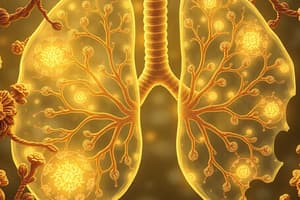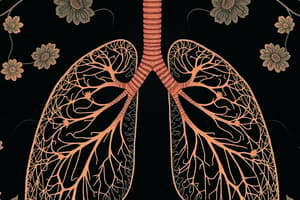Podcast
Questions and Answers
What is the role of the type-II alveolar cells?
What is the role of the type-II alveolar cells?
- Facilitating gas exchange
- Phagocytizing particulate matter
- Providing structural support to alveoli
- Secreting surfactant (correct)
How does surface tension affect the behavior of liquid molecules at an air-liquid interface?
How does surface tension affect the behavior of liquid molecules at an air-liquid interface?
- It creates equal attraction for surface and subsurface molecules.
- It results in a net downward pull on surface molecules. (correct)
- It allows subsurface molecules to be exposed to air.
- It prevents evaporation by trapping air underneath the liquid.
What feature of the alveoli helps to equalize pressure?
What feature of the alveoli helps to equalize pressure?
- Surfactant secretion
- Alveolar pores (correct)
- Type-I cells
- Pulmonary capillaries
Which of the following statements about surface tension is true?
Which of the following statements about surface tension is true?
What is a primary function of the respiratory membrane?
What is a primary function of the respiratory membrane?
What occurs to a paper clip when placed on the surface of water?
What occurs to a paper clip when placed on the surface of water?
Which component of the alveoli is primarily involved in reducing surface tension?
Which component of the alveoli is primarily involved in reducing surface tension?
What characteristic of surface molecules leads to the phenomenon of surface tension?
What characteristic of surface molecules leads to the phenomenon of surface tension?
What is the primary role of surfactant in lung physiology?
What is the primary role of surfactant in lung physiology?
How does the compliance of a saline-inflated lung compare to that of an air-inflated lung?
How does the compliance of a saline-inflated lung compare to that of an air-inflated lung?
According to LaPlace's Law, what effect does radius have on pressure in the alveoli?
According to LaPlace's Law, what effect does radius have on pressure in the alveoli?
What would likely happen to lung compliance in the absence of surfactant?
What would likely happen to lung compliance in the absence of surfactant?
What does the hysteresis observed in air-inflated lungs indicate?
What does the hysteresis observed in air-inflated lungs indicate?
Which of the following statements about surface tension in the alveoli is true?
Which of the following statements about surface tension in the alveoli is true?
What is the major component of pulmonary surfactant?
What is the major component of pulmonary surfactant?
What is one of the functions of surfactant in the alveoli?
What is one of the functions of surfactant in the alveoli?
Why does a saline-inflated lung exhibit no hysteresis?
Why does a saline-inflated lung exhibit no hysteresis?
What effect does decreasing surface tension have on the work of breathing?
What effect does decreasing surface tension have on the work of breathing?
What is the effect of surfactant on the surface tension in the alveoli?
What is the effect of surfactant on the surface tension in the alveoli?
According to Laplace's Law, how does the radius of an alveolus affect intraluminal pressure?
According to Laplace's Law, how does the radius of an alveolus affect intraluminal pressure?
What is a consequence of not having surfactant in alveoli?
What is a consequence of not having surfactant in alveoli?
How does the concentration of surfactant change with alveolar size?
How does the concentration of surfactant change with alveolar size?
What happens to the intraluminal pressure when surfactant is present?
What happens to the intraluminal pressure when surfactant is present?
What occurs to a collapsed alveolus (atelectatic) when surfactant is present?
What occurs to a collapsed alveolus (atelectatic) when surfactant is present?
What impact does surfactant have on lung compliance?
What impact does surfactant have on lung compliance?
Why does gas flow from a smaller alveolus to a larger one in the absence of surfactant?
Why does gas flow from a smaller alveolus to a larger one in the absence of surfactant?
What is the primary role of surfactant in respiratory physiology?
What is the primary role of surfactant in respiratory physiology?
What process describes the entry of surfactant molecules into the surface during expiration?
What process describes the entry of surfactant molecules into the surface during expiration?
How is lung compliance calculated?
How is lung compliance calculated?
What happens to surfactant molecules during inspiration?
What happens to surfactant molecules during inspiration?
What is the intrapleural pressure at the base of the lung compared to the apex, assuming values of -2 cmH2O and -9 cmH2O respectively?
What is the intrapleural pressure at the base of the lung compared to the apex, assuming values of -2 cmH2O and -9 cmH2O respectively?
What effect does gravity have on the intrapleural pressure at functional residual capacity?
What effect does gravity have on the intrapleural pressure at functional residual capacity?
What is the transpulmonary pressure at the apex of the lung compared to the base, given values of +9 cmH2O and +2 cmH2O respectively?
What is the transpulmonary pressure at the apex of the lung compared to the base, given values of +9 cmH2O and +2 cmH2O respectively?
What occurs to surfactant molecules that are 'squeezed out' during expiration?
What occurs to surfactant molecules that are 'squeezed out' during expiration?
During a change in lung volume, what does a change in intrapleural pressure from -3 cmH2O to -8 cmH2O indicate?
During a change in lung volume, what does a change in intrapleural pressure from -3 cmH2O to -8 cmH2O indicate?
If the change in volume is 1 L with a change in pressure of 5 cmH2O, what is the lung compliance?
If the change in volume is 1 L with a change in pressure of 5 cmH2O, what is the lung compliance?
How does the compliance of the alveoli at the apex of the lung compare to that at the base during respiration?
How does the compliance of the alveoli at the apex of the lung compare to that at the base during respiration?
Which factor contributes most significantly to decreased compliance in lung function?
Which factor contributes most significantly to decreased compliance in lung function?
What is the primary effect of obstructive lung disease on pulmonary compliance?
What is the primary effect of obstructive lung disease on pulmonary compliance?
At functional residual capacity, which statement is true about the alveoli at different lung regions?
At functional residual capacity, which statement is true about the alveoli at different lung regions?
Which condition is NOT associated with decreased compliance in the lungs?
Which condition is NOT associated with decreased compliance in the lungs?
Study Notes
Mechanics of Breathing
- Alveoli are surrounded by elastic fibers and smooth muscle, which allows them to expand and contract with air flow.
- Alveolar pores equalize pressure within the alveoli.
- Macrophages engulf particulate matter in the alveoli.
- The respiratory membrane separates the alveoli from the pulmonary capillaries and consists of type I and type II cells.
- Type II cells secrete surfactant, which reduces surface tension and promotes alveolar inflation.
Surface Tension
- Surface tension in the alveoli is a force that minimizes the exposed surface area of a liquid.
- Surface tension results from the attraction between liquid molecules at the air-liquid interface.
- This attraction creates a surface film and causes a net downward pull on the surface molecules.
- Surface tension is demonstrated by placing a paper clip on the surface of water; it stays afloat due to this force.
Lung Compliance and Surface Tension
- Air-inflated lungs exhibit hysteresis, meaning the path of expiration differs from inspiration.
- Air-inflated lungs need higher positive pressures compared to saline-inflated lungs, due to surface tension.
- Saline-inflated lungs show higher compliance (greater volume change for a given pressure change) and no hysteresis.
- A lung without surfactant has lower compliance than a normal lung, requiring more pressure for inflation.
Surfactant
- Surfactant is a phospholipid secreted by type II epithelial cells.
- It reduces surface tension, decreases the work of breathing, increases compliance, stabilizes alveolar size and dries the alveoli.
- Dipalmitoyl phosphatidylcholine, the major component of surfactant, has hydrophobic and hydrophilic portions, allowing it to orient itself at the air-water interface.
Surfactant and Alveolar Stability
- Laplace's Law (P = 2T/r) describes the relationship between intra-alveolar pressure, surface tension, and alveolar radius.
- Without surfactant, smaller alveoli have higher intra-alveolar pressure, leading to gas flow from smaller to larger alveoli and atelectasis (collapsed alveoli).
- Surfactant lowers surface tension in smaller alveoli, reducing pressure and preventing atelectasis.
Surfactant Concentration and Alveolar Size
- Surfactant concentration at the air-water interface is higher in smaller alveoli, minimizing surface tension.
- Surfactant molecules are squeezed closer together during expiration, further reducing surface tension.
- During inspiration, the molecules separate and re-associate with the film during the next expiration, a process called respreading.
Total Lung Compliance
- Lung compliance is the change in lung volume divided by the change in lung distending pressure (CL = ∆V/∆P).
- Normal lung compliance is approximately 0.2 L/cm H2O.
Pulmonary Compliance and Gravity
- Gravity affects intrapleural pressure and lung compliance.
- Intrapleural pressure is less negative at the base of the lung than at the apex due to gravity's downward pull.
- This difference in pressure leads to higher transpulmonary pressure at the apex, making the alveoli more distended and less compliant compared to the base.
- During inspiration, the volume change at the apex is smaller than at the base for the same change in transpulmonary pressure.
Pulmonary Compliance and Disease States
- Emphysema increases compliance by destroying lung elastin and collagen.
- Lung compliance is decreased by:
- High lung volume
- Restrictive lung diseases
- Alveolar edema
- Surfactant deficiency
Studying That Suits You
Use AI to generate personalized quizzes and flashcards to suit your learning preferences.
Related Documents
Description
Explore the critical concepts of alveolar mechanics, including how alveoli function and the role of surface tension in respiratory physiology. This quiz covers topics such as alveolar structure, the significance of surfactant, and the effects of surface tension on lung compliance. Test your understanding of these essential components of the respiratory system.




